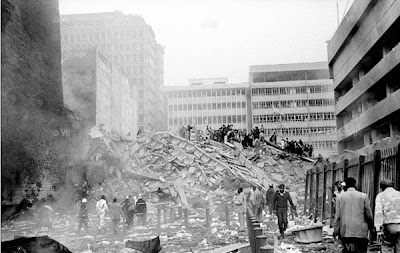
The 1998 United States embassy bombings were a series of attacks that occurred on August 7, 1998, in which hundreds of people were killed in simultaneous truck bomb explosions at the United States embassies in the East African capitals of Dar es Salaam, Tanzania and Nairobi, Kenya. The date of the bombings marked the eighth anniversary of the arrival of American forces in Saudi Arabia. The attacks were linked to local members of the Egyptian Islamic Jihad, brought Osama binLaden and Ayman al-Zawahiri to the attention of the American public for the first time, and resulted in the U.S.
Federal Bureau of Investigation placing bin Laden on its Ten Most Wanted Fugitives list. Fazul Abdullah Mohammed would be credited for being the mastermind behind the bombings. The two embassies were both bombed at the same time by truck bombs. The bombings were the work of a local cell of Al Qaeda. Al Qaeda was led by Osama Bin Laden 213 people were killed in Nairobi including 12 Americans. In Dar es Salam 12 people were killed. In response President Clinton ordered cruise missile attacks on suspected Al Qaeda targets in Sudan and Afghanistan.
The bombings are widely believed to have been revenge for American involvement in the extradition, and alleged torture, of four members of Egyptian Islamic Jihad (EIJ) who had been arrested in Albania in the two months prior to the explosions.[4] Between June and July,Ahmad Isma'il 'Uthman Saleh, Ahmad Ibrahim al-Sayyid al-Naggar, Shawqi Salama Mustafa Atiya and Mohamed Hassan Tita were allrenditioned from Albania to Egypt, with the cooperation of the United States; the four men were accused of participating in the assassination of Rifaat el-Mahgoub, as well as a later plot against the Khan el-Khalili market in Cairo.[5] The following month, a communique was issued warning the United States that a "response" was being prepared to repay them for their interference.
On August 7, between 10:30 am and 10:40 am suicide bombers in trucks laden with explosives parked outside the embassies in Dar es Salaam and Nairobi, and almost simultaneously detonated. In Nairobi, approximately 212 people were killed, and an estimated 4,000 wounded; in Dar es Salaam, the attack killed at least 11 and wounded 85. Seismological readings analyzed after the bombs indicated energy of between 3–17 tons of high explosive material.[15] Although the attacks were directed at American facilities, the vast majority of casualties were local citizens; 12 Americans were killed,[16] including two Central Intelligence Agency employees in the Nairobi embassy, Tom Shah and Molly Huckaby Hardy, and one Marine, Sergeant Jesse Aliganga, a Marine Security Guard at the Nairobi embassy. In response to the bombings, President Bill Clinton ordered Operation Infinite Reach, a series of cruise missile strikes on targets in Sudan and Afghanistan on August 20, 1998, announcing the planned strike in a prime time address on American television.
The attack on the U.S. embassy in Nairobi destroyed the embassy and killed 12 Americans and 201 others, almost all Kenyans. About 5,000 people were injured. The attack on the U.S. embassy in Dar es Salaam killed 11 more people, none of them Americans. The US in cooperation with the government of Tanzania has since broke ground on a new embassy. The US has also indicted Osama Bin Laden as the mastermind behind the embassy attacks and offered a five million dollar reward for his arrest and conviction. The US attacked Sudan and Afghanistan with cruise missiles as a response to the attacks on the embassies. The US attacked an alleged chemical weapons producing plant in Sudan with 13 cruise missile which resulted in the death of the night watchmen. This attack has come under a great deal of criticism because there has been no corroborating evidence to support the attack. The Afghanistan attack came in the form of over 70 cruise missile at three separate terrorist camps. This attack killed an estimated 24 people but failed to get Osama Bin Laden.





0 comments:
Post a Comment